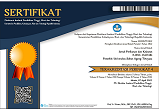Evaluation of fermented of Palm Kernel Meal by Saccharomyces cerevisiae in Tilapia Fed
Abstract
Keywords
Full Text:
PDFReferences
Azizah N, Al-Baarri AN, Mulyani S. 2012. Pengaruh lama fermentasi terhadap kadar alkohol, pH, dan produksi gas pada proses fermentasi bioethanol dari whey dengan substitusi kulit nanas. Jurnal Aplikasi Teknologi Pangan 1 (2): 72-77.
Buckle KA, Edwards RA, Fleet GH & Wootton M. 2013. Ilmu pangan. (Penerjemah Adiono dan Purnomo H) Jakarta: Universitas Indonesia press. 365 hlm
Cheng ZJ, Hardy RW, Usry JL. 2003. Efects of lysine supplementation in plant protein-based diets on the performance of rainbow trout (Oncorhynchus mykiss) and apparent digestibility coeficients of nutrients. Aquaculture 215: 255-265.
Fardiaz S. 1988. Fisiologi Fermentasi. Bogor: Pusat Antar Universitas-Institut Pertanian Bogor.
Hadadi A, Herry, Setyorini A, Surahman, Ridwan E. 2007. Pemanfaatan limbah sawit untuk bahan pakan ikan. Jurnal Budidaya Air Tawar 4 (1): 11-18.
Hassan MS, Soltan MA, Abdel-Moez AM. 2015. Nutritive value of soybean meal after solid state fermentation with Saccharomyces cerevisiae for Nile tilapia, Oreochromis niloticus. Animal Feed Science and Technology 201: 89-98.
Hassan MS, Soltan MA, Eman Y, Mohammady, Elashry AM, El-Haroun ER, Davies SJ. 2019. Growth and physiological responses of nile tilapia, Oreochromis niloticus fed dietary fermented sunflower meal inoculated with Saccharomyces cerevisiae and Bacillus subtilis. Aquaculture 495: 592-601.
Hertrampf JW dan Piedad-Pascual F. 2000. Handbook on Ingredients for Aquaculture feeds. Los Angles: Kluwer Academic Publishers. 624 pp.
Huisman EA. 1987. Principles of Fish Production. Wageningan, Netherland: Department of Fish Culture and Fisheries, Wageningen Agriculture University. 170p.
[KKP] Kementrian Kelautan dan Perikanan. 2019. Kelautan dan perikanan dalam angka. https://kkp.go.id/setjen/satudata/artikel/9669-kelautan-dan-perikanan-dalam-angka -2018-telah-terbit. [diakses 10 Juli 2019].
Kustyawati EM, Sari M, dan Haryati T. 2013. Efek Fermentasi Dengan Saccharomyces cerevisiae terhadap Karakteristik Biokimia Tapioka. AGRITECH 33 (3): 281 - 287.
[NRC] National Research Council. 1993. Nutrient Requirement of Fish. Washington DC: National Academic Press. 273pp.
[NRC] National Research Council. 2011. Nutrient requirements of fish and shrimp. Washington DC: The National Academies Press. 376 pp.
Orunmuyi M, Bawa GS, Adeyinka FD, Daudu OM, Adeyinka IA. 2006. Effects of graded levels of palm kernel cake on performance of grower rabbits. Pakistan Journal of Nutritions 5 (1): 71-74.
Padmore JM. 1995. Animal Feed. In: [AOAC] Association of Official Analytical Chemists. 1995. Official Methods of Analysis 16th ed Volume II. Maryland.
Pamungkas W, Jusadi D, Utomo NBP. 2011. Uji Kecernaan Bungkil Kelapa Sawit yang dihidrolisis dengan Enzim Cairan Rumen Domba sebagai Pakan Benih Ikan patin Siam (Pangasius hypopthalmus). Prosiding Forum Ilmiah Teknologi Akuakultur (FITA) Bali, 19-21 Juli 2011. Jakarta: Pusat Penelitian dan Pengembangan Perikanan Budidaya. hal 795-800.
Pamungkas W. 2012. Koefisien kecernaan fraksi serat bungkil kelapa sawit yang dihidrolisis dengan enzim asal cairan rumen domba sebagai pakan benih ikan patin siam (Pangasius hypophthalmus). Jurnal Riset Akuakultur 7 (3): 437-445.
Pamungkas W. 2013. Uji palatabilitas tepung bungkil kelapa sawit yang dihidrolisis dengan enzim rumen dan efek terhadap respon pertumbuhan benih ikan patin siam (Pangasius hypophthalmus Sauvage). Berita Biologi 12 (3): 359-366.
Putra AN, Widanarni, Utomo NBP. 2015. Growth Performance of Tilapia (Oreochromis niloticus) Fed with Probiotic, Prebiotic and Synbiotic in Diet. Pakistan Journal of Nutrition 14 (5): 263-268.
Putra AN and Romdhonah Y. 2019. Effects of dietary Bacillus NP5 and sweet potato extract on growth and digestive enzyme activity of dumbo catfish, Clarias sp.. Jurnal Akuakultur Indonesia 18 (1): 80-88.
Puastuti W, Yulistiani D, Suasana IWR. 2014. Evaluasi nilai bungkil inti sawit yang difermentasi dengan kapang sebagai sumber protein ruminansia. Jurnal Ilmu Ternak dan Veteriner 19 (2): 143-151.
Soebjakto S. 2015, November-Desember. Komitmen Total Menuju Kemandirian Pakan. Tabloid Akuakultur Indonesia 3 (18): 3.
Suprayudi MA, Edriani G, Ekasari J. 2012. Evaluasi kualitas produk fermentasi berbagai bahan baku hasil samping agroindustri lokal: pengaruhnya terhadap kecernaan serta kinerja pertumbuhan juvenil ikan mas. Jurnal Akuakultur Indonesia 11 (1):1-10.
Tacon AGJ dan Metian M. 2008. Global overview on the use of fish meal and fish oil in indusstrially compounded aquafeed: Trends and future prospects. Aquaculture 285: 146-158.
Takeuchi. 1988. Labrotary Work-Chemical Evaluation of Dietary Nutriens. P.179-233, In Watanabe (Ed) Fish Nutrition and Mariculture. Japan: Kanagawa International Fisheries Training. Japan International Cooperation Agency (JICA).
Tantiakitti C. 2014. Review article: Feed palatability and the alternative protein sources in shrimp feed. Songklanakarin Journal of Science and Technology 36 (1): 51-55.
Watanabe T. 1988. Fish nutrition and mariculture. Japan: JICA Textbook. The general aquaculture course. Department of aquatic biosciences. Tokyo University of Fisheries. 233 pp.
DOI: http://dx.doi.org/10.33512/jpk.v10i1.8978
Refbacks
- There are currently no refbacks.



_-_Copy1.png)